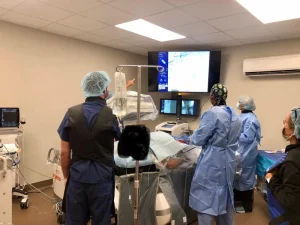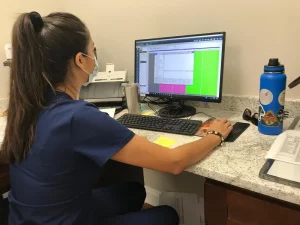FAQ: Endovascular Cath Lab Procedure
 Q. Why can’t I eat before my procedure?
Q. Why can’t I eat before my procedure?
We do not want you to have anything to eat or drink before your procedure to make sure that your stomach is empty. This helps to decrease the risk of nausea, vomiting and breathing complications.
Q. Why can’t I take my Metformin?
Contrast will be given to you in your arteries during the procedure. Your kidneys get rid of the contrast tirough your urine, which is how Metformin is excreted as well. By not taking your Metformin, it allows your kidneys to completely excrete the contrast minimizing the risk of damaging your kidneys. This is also why it is important to stay hydrated after your procedure, to flush out the contrast dye from your system.
Q. Why do I need an IV started before the procedure?
An IV is started to administer IV fluids and medications, such as conscious sedation, pain medication and blood thinners.
Q. Why do I have to have my procedural site shaved?
Removing hair just prior to the procedure using a clipper reduces the risk of infection.
Q. Why do I have to arrive 1.5 hours prior to my procedure start time?
You have to arrive early to provide adequate time for your laboratory results to be reported and to allow your nurse enough time to complete the pre-procedural assessments, history review and procedural preparation tasks.
Q. Why are the cath lab procedural rooms so cold?
The temperature is kept below a certain level to maintain equipment sterility; this was done by design per regulations. Also so our specialized Xera equipment doesn’t overheat.
Q. How long do stents last and are they removable?
Stents are permanent and cannot be removed. There are no nerve endings inside your arteries so you will not feel your stent. Stents cannot move after being deployed by the physician. Also, the stent will not rust.
Q. Can I walk through metal detectors if I have a stent?
Yes. Stents will not set off metal detectors.
Q. Why do I have to take an anti-platelet medication after receiving a stent?
Anti-platelet medication reduces the risk of your stent becoming clogged because the medication works with the stent’s special drug coating.
Q. Can I stop taking my medication if I feel better?
No, you must continue to take your medications as prescribed even if you feel better. If you stop taking your medications, you are at an increased risk of a blood clot forming in or near your stent which may lead to complications.
Q: Will I be asleep for the procedure?
Cath lab procedures are performed while you are awake but sedated, A Cardiovascular Cath Lab staff member will start an IV and administer conscious sedation to you once you are in the procedure room. This way of sedation allows you to be comfortable and for your physician to still be able to communicate with you.
Q. Why do I need to be on bed rest?
You will be on bed rest from anywhere between three to eight hours after your procedure. Bed rest gives the puncture site adequate time to heal to prevent bleeding complications.
If you have any questions prior to your procedure please call the SVPC at (850)532-6303 or write down your questions for the physician.
 PROCEDURE INFORMATION
PROCEDURE INFORMATION
What do I need to do before my procedure?
You will need to arrange transportation to and from the office/hospital. We will not know when you will be discharged until the procedure is completed.
When you arrive
- You can expect to spend about 1-2 hours in one of our pre-procedural rooms. During this time, we may:
- Sign consent forms
- Perform physical assessments
- Update your medical history and medications
- Obtain blood work
- Perform diagnostic tests if necessary
- Start an IV to administer fluids and medications
- Prep the skin area of your procedure site
- Give oral medications in pill form prior to your procedure to prevent a contrast dye reaction and to help you relax
- The physician performing your procedure will speak with you. This is a good time for you to ask questions about your procedure and the recovery process.
During your procedure
- The procedure typically takes about one to two hours. Your loved ones will be taken to our waiting area until the procedure is done.
- You will be brought to the Cardiovascular Cath Lab procedure room where you are expected to lay flat on the X-ray table with the support of a pillow for your head. The procedure room tends to be very cool, which is by design, so we will comfort you with a warm blanket.
Cardiovascular Cath Lab associates will then proceed to prep you for the procedure by attaching a heart monitor and other pertinent equipment. You will have oxygen placed in your nose and your procedure site will be washed with an antibacterial cleanser. A sterile covering will drape over you, and it will be very important for you to lie still.
- The CRNA/anesthesia team member with you in the procedure room will administer conscious sedation through your IV to help you relax and stay comfortable. We will administer sedation while closely monitoring your vital signs for your safety.
- If you begin to experience any discomfort, please let the nurse or physician know so that we can make you comfortable.
- A tiny needle will be used to inject local anesthetic into the skin at the procedure sites. You will feel a pinch and a burn from this medication. but the area will become numb very quickly.
- A small hollow tube or catheter is then inserted into the groin area or occasionally in the lower leg.
- As the X-ray images are taken, the table will move and the lights will turn on and off.
- Multiple views of your arteries are taken as contrast dye is injected into your bloodstream. It is normal to feel a warm sensation when the dye is injected; this is only temporary. The results of the angiogram will help your healthcare provider determine which treatment option is best. If there is a narrowing of the artery that the physician determines needs to be fixed at that time, a balloon and/or scent will be used.
- After the procedure is completed the small hollow tube will be removed and the puncture site will be sealed with a special closure device or a special wrist band by applying pressure over the artery.
- You will need to remain on bed rest for approximately one to four hours after the procedure.
- The physician will speak with you and your family about your results.
After your peripheral angiogram
- Immediately after your procedure, it will be important for you to lie still, keep your head on your pillow and not bend your leg.
- A nurse will monitor your vital signs, procedure site and pulses frequently.
- Depending on the results of the procedure and what interventions were done will determine how long you will need to stay after your procedure. Some patients will stay for up to eight hours or overnight. You will be given discharge information prior to leaving.
- You may be prescribed an antiplatelet or anticoagulant medication to prevent blood clotting.
Risks of the procedure, although very rare:
- Bleeding, bruising, infection or pain at the catheter insertion site
- Allergic reaction to the contrast dye
- Artery damage requiring surgery
- Kidney concerns from the contrast dye
